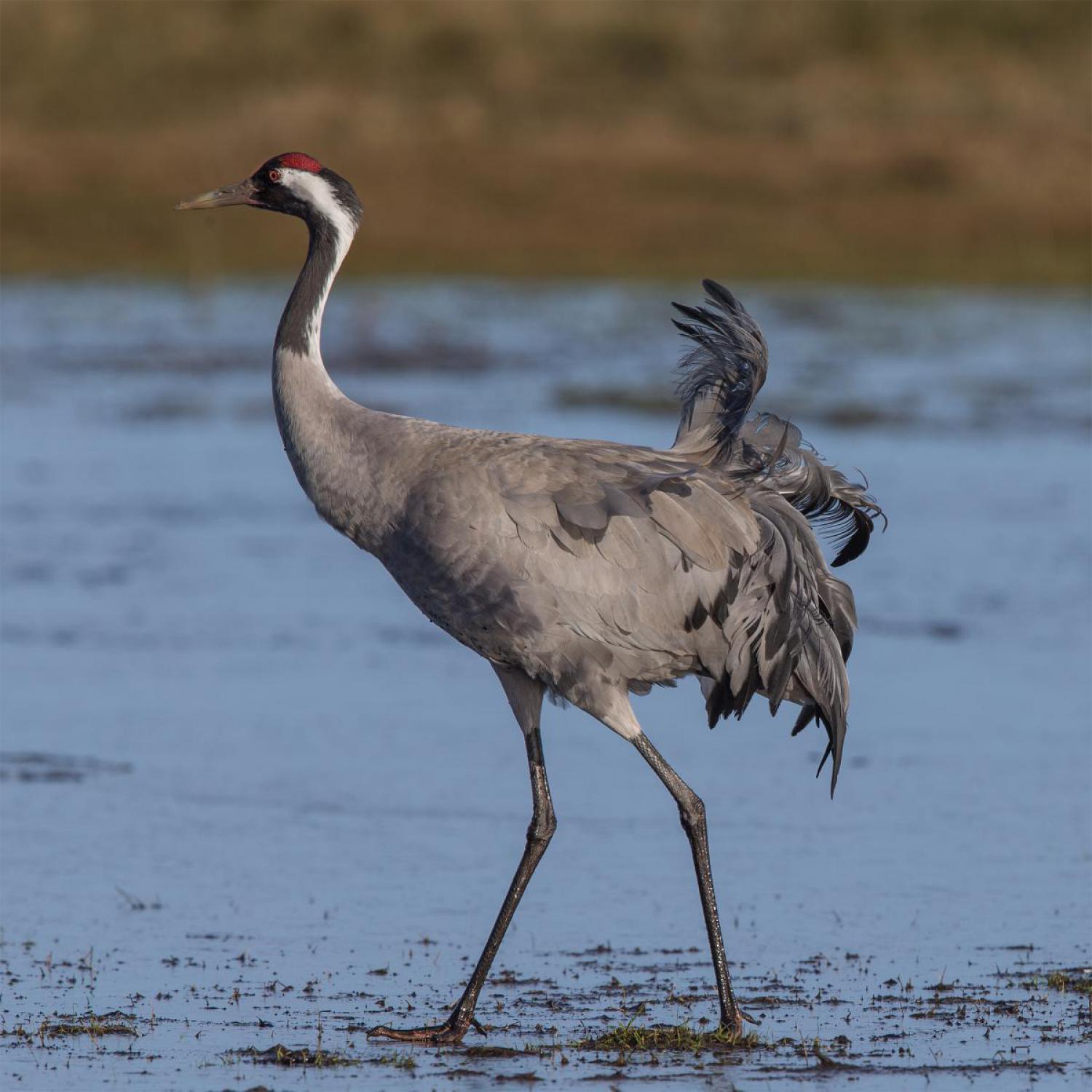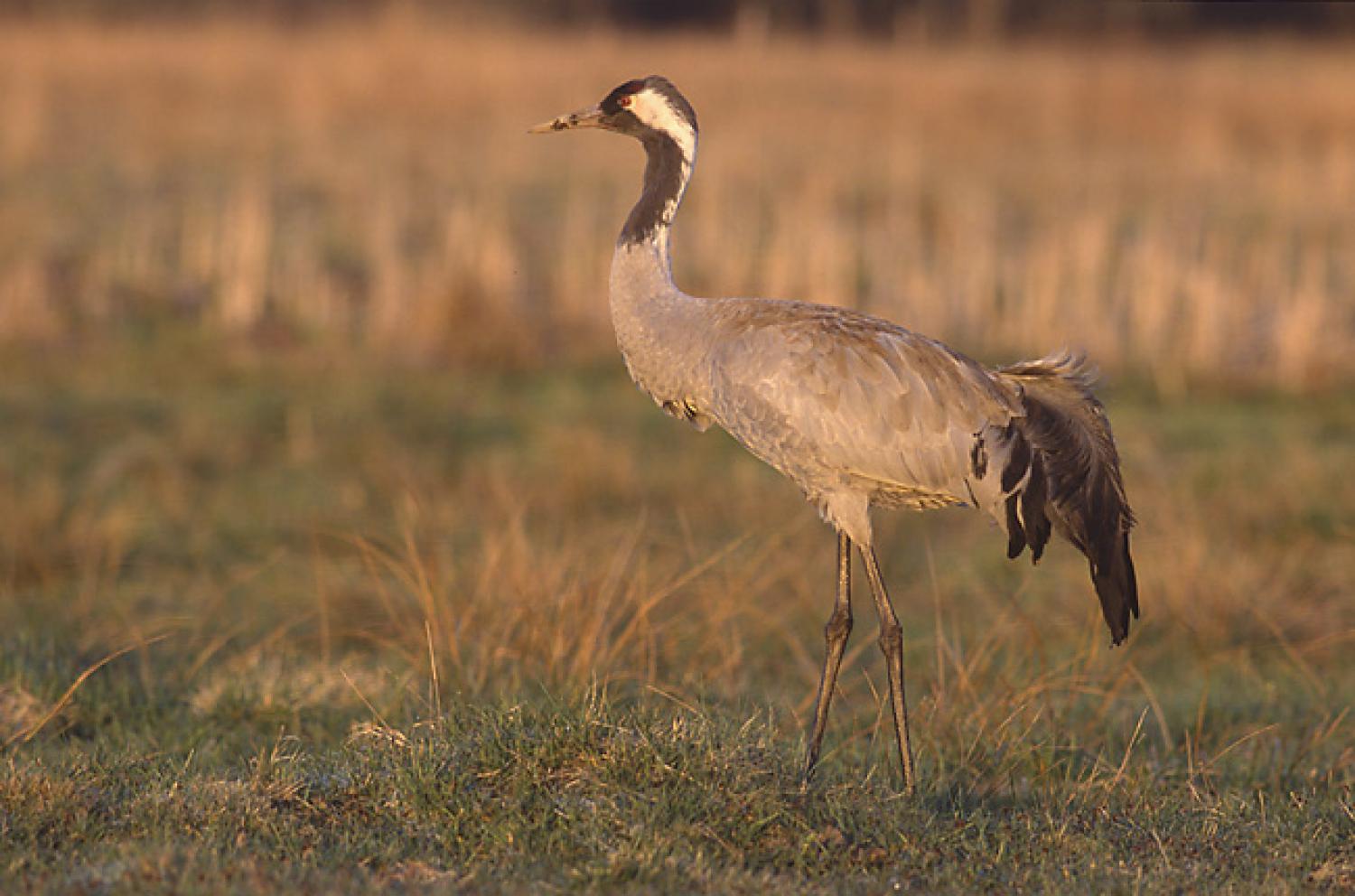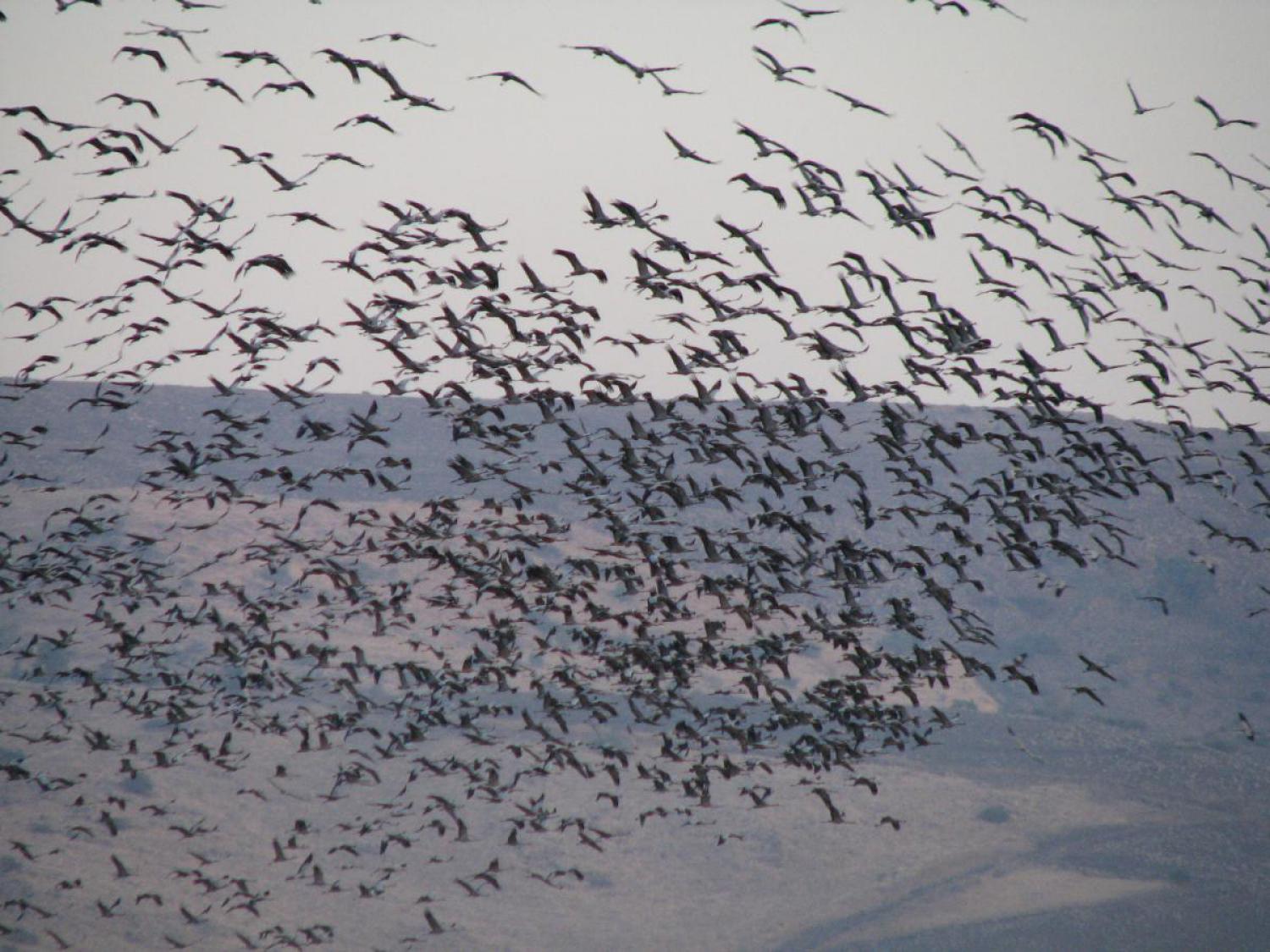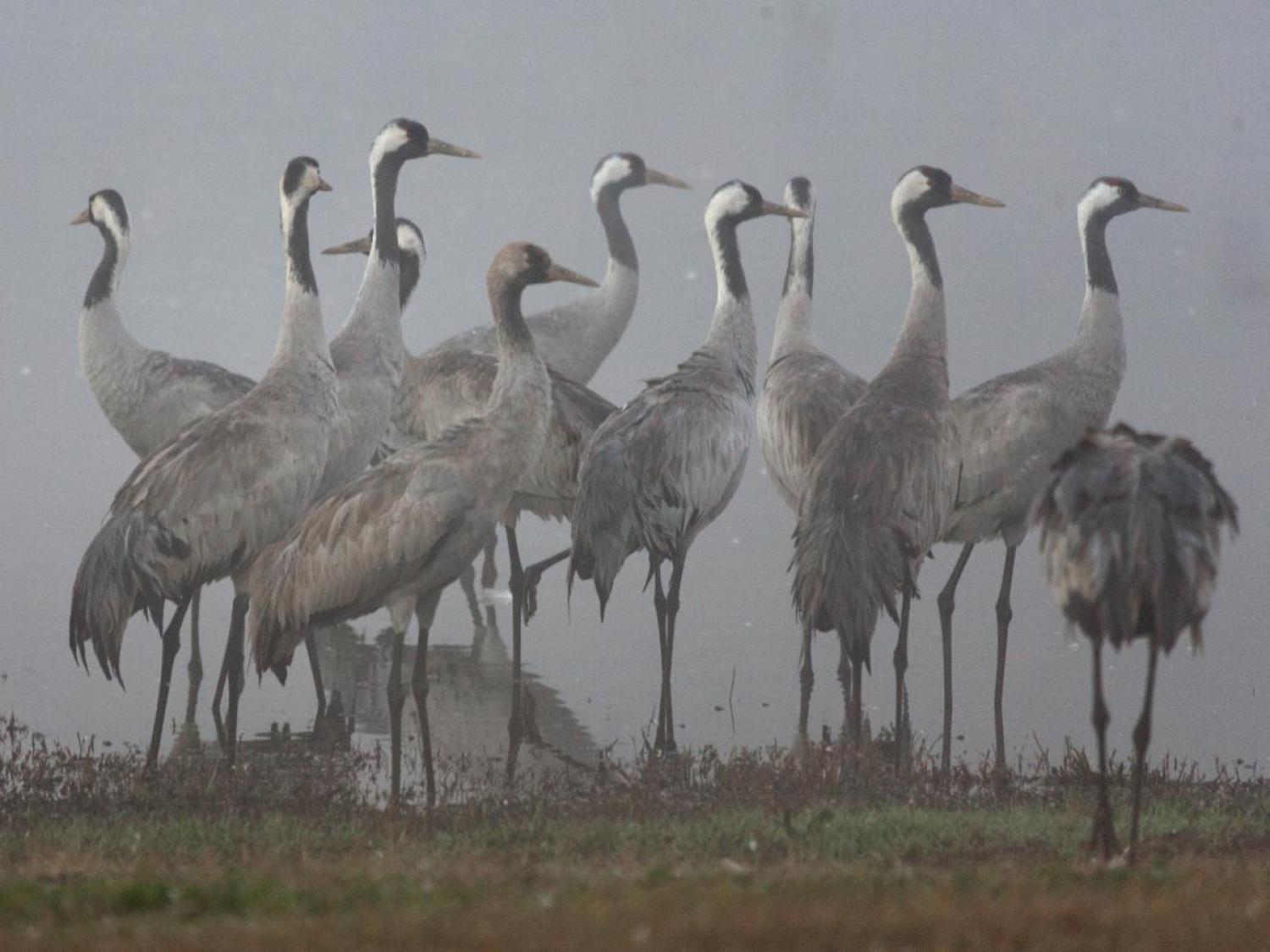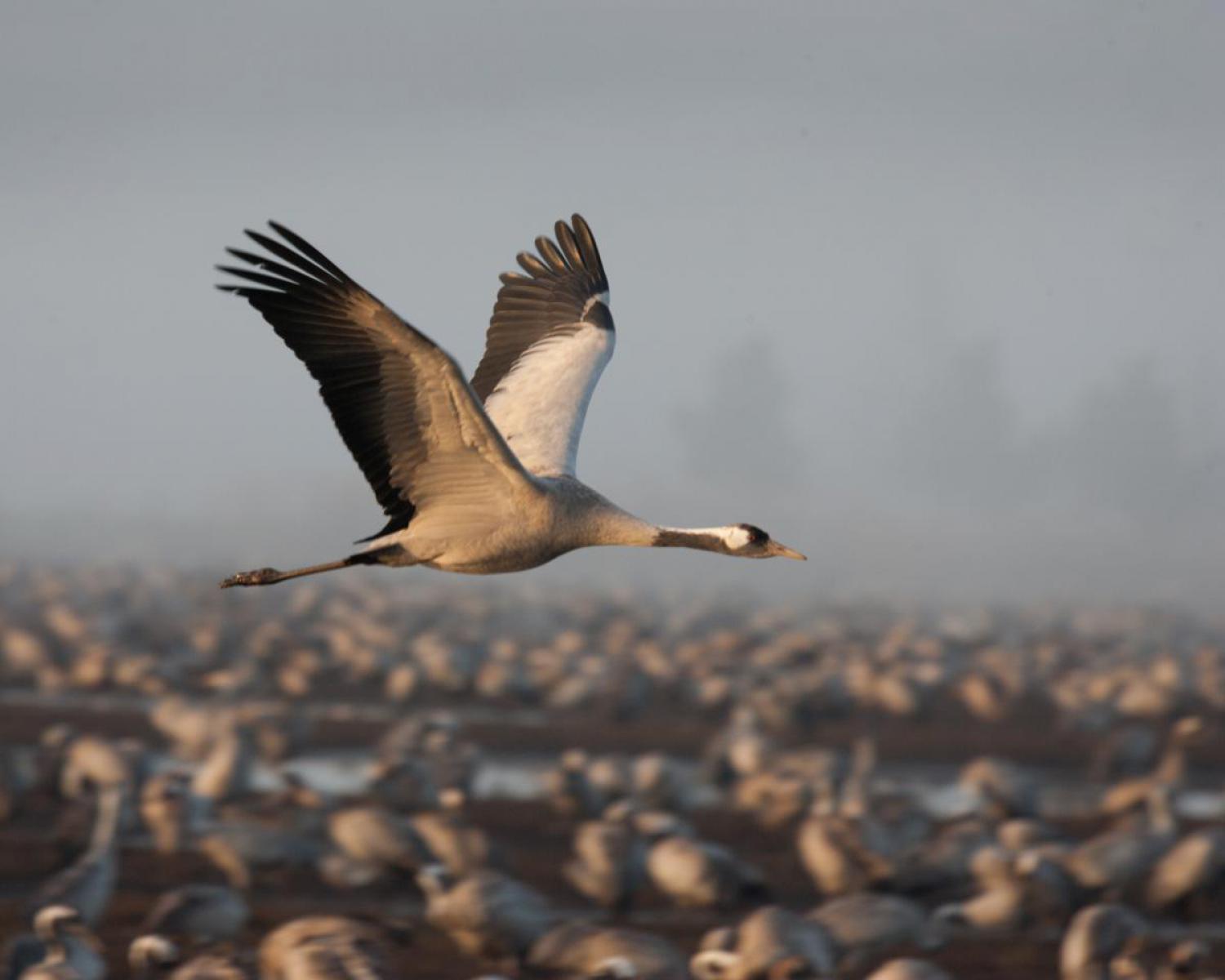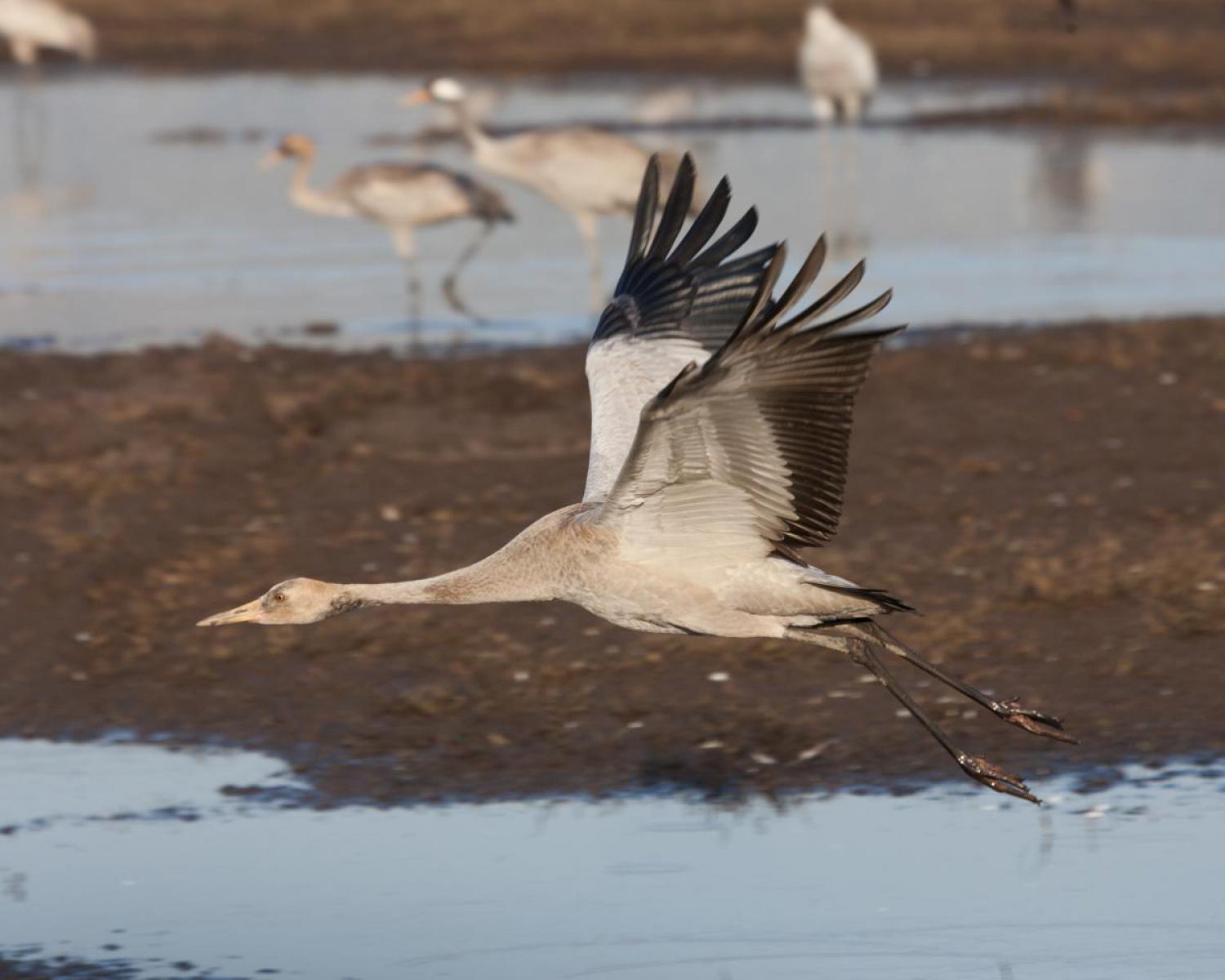Species of Thailand
Common crane
Grus grus
Carolus Linnaeus, 1758
In Thai: นกกระเรียนพันธุ์ยุโรป
The common crane (Grus grus), also known as the Eurasian crane, is a bird of the family Gruidae, the cranes. A medium-sized species, it is the only crane commonly found in Europe besides the demoiselle crane (Anthropoides virgo). Along with the sandhill (Grus canadensis) and demoiselle cranes and the brolga (Grus rubicunda), it is one of only four crane species not currently classified as threatened with extinction or conservation dependent at the species level.
Description
The common crane is a large, stately bird and a medium-sized crane. It is 100 – 130 cm long with a 180 – 240 cm wingspan. The body weight can range from 3 to 6.1 kg, with the nominate subspecies averaging around 5.4 kg and the eastern subspecies (G. g. lilfordi) averaging 4.6 kg. Among standard measurements, the wing chord is 50.7 - 60.8 cm long, the tarsus is 20.1 - 25.2 cm and the exposed culmen is 9.5 - 11.6 cm.
This species is slate-grey overall. The forehead and lores are blackish with a bare red crown and a white streak extending from behind the eyes to the upper back. The overall colour is darkest on the back and rump and palest on the breast and wings. The primaries, the tips of secondaries, the alula, the tip of the tail, and the edges of upper tail coverts are all black and the greater coverts droop into explosive plumes. This combination of colouration ultimately distinguishes it from similar species in Asia, like the hooded (G. monacha) and black-necked cranes (G. nigricollis). The juvenile has yellowish-brown tips to its body feathers and lacks the drooping wing feathers and the bright neck pattern of the adult, and has a fully feathered crown. Every two years, before migration, the adult common crane undergoes a complete moult, remaining flightless for six weeks, until the new feathers grow.
It has a loud trumpeting call, given in flight and display. The call is piercing and can be heard from a considerable distance. It has a dancing display, leaping with wings uplifted, described in detail below.
Distribution
This species is found in the northern parts of Europe and Asia. Formerly the species was spread as far west as Ireland, but about 200 years ago, it became extinct there. However, it has since started to return to Ireland naturally and there are now plans to help it return to Ireland on a greater scale. The common crane is an uncommon breeder in southern Europe, smaller numbers breeding in Greece, Yugoslavia, Romania, Denmark and Germany. Larger breeding populations can found in Scandinavia, especially Finland and Sweden. The heart of the breeding population for the species is in Russia, however, where possibly up to 100, 000 cranes of this species can be found seasonally. In Russia, it is distributed as a breeder from the Ukraine region to the Chukchi Peninsula. The breeding population extends as far south as Manchuria but almost the entire Asian breeding population is restricted to Russia.
The species is a long distance migrant predominantly wintering in northern Africa. Autumn migration is from August to October and spring migration is in March through May. Important staging areas occur anywhere from Sweden and Germany to China (with a large one around the Caspian Sea) and many thousand cranes can be seen in one day in the Autumn. Some birds winter in southern Europe, including Portugal, Spain and France. Most eastern common cranes winter in the river valleys of Sudan, Ethiopia, Tunisia and Eritrea with smaller numbers in Turkey, northern Israel, Iraq and parts of Iran. The third major wintering region is in the northern half of Indian subcontinent, including Pakistan. Minimal wintering also occurs in Burma, Vietnam and Thailand. Lastly, they winter in eastern China, where they are often the most common crane (outnumbering black-necked cranes ten-to-one). Migrating flocks fly in a "V" formation.
It is a rare visitor to Japan and Korea, mostly blown over from the Chinese wintering population, and is a rare vagrant to western North America, where birds are occasionally seen with flocks of migrating sandhill cranes.
Habitat
In Europe, the common crane predominantly breeds in boreal and taiga forest and mixed forests, from an elevation of sea-level to 2200 m. In northern climes, it breeds in treeless moors, on bogs, or on dwarf heather habitats, usually where small lakes or pools are also found. In Sweden, breeders are usually found in small, swampy openings amongst pine forests, while in Germany, marshy wetlands are used. Breeding habitat used in Russia are similar, though they can be found nesting in less likely habitat such as steppe and even semi-desert, so long as water is near. Primarily, the largest number of common cranes are found breeding in wooded swamps, bogs and wetlands and seem to require quiet, peaceful environs with minimal human interference. They occur at low density as breeders even where common, typically ranging from 1 to 5 pairs per 100 km2.
In winter, this species moves to flooded areas, shallow sheltered bays, and swampy meadows. During the flightless moulting period there is a need for shallow waters or high reed cover for concealment. Later, after the migration period, the birds winter regularly in open country, often on cultivated lands and sometimes also in savanna-like areas, for example on the Iberian Peninsula.
Diet
The common crane is omnivorous, as are all cranes. It largely eats plant matter, including roots, rhizomes, tubers, stems, leaves, fruits and seeds. They also commonly eat, when available, pond-weeds, heath berries, peas, potatoes, olives, acorns, cedarnuts and pods of peanuts. Notably amongst the berries consumed, the cranberry, is possibly named after the species.
Animal foods become more important during the summer breeding season and may be the primary food source at that time of year, especially while regurgitating to young. Their animal foods are insects, especially dragonflies, and also snails, earthworms, crabs, spiders, millipedes, woodlice, amphibians, rodents, and small birds.
Common cranes may either forage on land or in shallow water, probing around with their bills for any edible organism. Although crops may locally be damaged by the species, they mostly consume waste grain in winter from previously harvested fields and so actually benefit farmers by cleaning fields for use in the following year. As with other cranes, all foraging (as well as drinking and roosting) is done in small groups, which may variously consist of pairs, family groups or winter flocks.
Breeding
This species usually lays eggs in May, though seldom will do so earlier or later. Like most cranes, this species displays indefinite monogamous pair bonds. If one mate dies, a crane may attempt to court a new mate the following year. Although a pair may be together for several years, the courtship rituals of the species are enacted by every pair each spring. The dancing of common cranes has complex, social meanings and may occur at almost any time of year. Dancing may include bobs, bows, pirouettes, and stops, as in various crane species. Aggressive displays may include ruffled wing feathers, throwing vegetation in the air and pointing the bare red patch on their heads at each other. Courtship displays begin with a male following the female in a stately, march-like walk. The unison call, consists of the female holding her head up and gradually lowering down as she calls out. The female calls out a high note and then the male follows with a longer scream in a similar posture. Copulation consists of a similar, dramatic display.
The nesting territory of common cranes is variable and is based on the local habitat. It can range in size from variously 2 to 500 ha acre. In common with sandhill cranes (and no other crane species), common cranes "paint" their bodies with mud or decaying vegetation, apparently in order to blend into their nesting environment. The nest is either in or very near shallow water, often with dense shore vegetation nearby, and may be used over several years. The size and placement of the nest varies considerably over the range, with Arctic birds building relatively small nests. In Sweden, an average nest is around 90 cm across.
The clutch of the common crane usually contains two eggs, with seldom one laid and, even more rarely, 3 or 4. If a clutch is lost early in incubation, the cranes may be able to lay another one within a couple of weeks. The incubation period is around 30 days and is done primarily by the female but occasionally by both sexes. If humans approach the nest both parents may engage in a distraction display but known ground predators (including domestic dogs (Canis lupus familiaris)) are physically attacked almost immediately.
New hatchlings are generally quite helpless but are able to crawl away from danger within a few hours, can swim soon after hatching and can run with their parents at 24 hours old. Chicks respond to danger by freezing, using their camouflaged brownish down to defend them beyond their fierce parents. Young chicks use their wings to stabilise them while running, while by 9 weeks of age they can fly short distances. The adult birds go through their postbreeding moult while caring for their young, rendering them flightless for about 5 to 6 weeks around the time the young also can't fly yet. According to figures of cranes wintering in Spain, around 48% birds have surviving young by the time they winter and around 18% are leading two young by winter. By the next breeding season, the previous years young often flock together. The age of sexual maturity in wild birds has been estimated at variously from 3 to 6 years of age. It is thought that it is common for this species to live up to 30 or 40 years of age.
Sociality
The common crane is a fairly social bird while not breeding. Flocks of up to 400 birds may be seen flying together during migration. Staging sites, where migrating birds gather to rest and feed in the middle of their migration, may witness thousands of cranes gathering at once. However, the flocks of the species are not stable social units but rather groups that ensure greater safety in numbers and collectively draw each other's attention to ideal foraging and roosting sites. Possibly due to a longer moult, younger and non-breeding cranes are usually the earliest fall migrants and may band together at that time of year.
Interspecies interactions
There are few natural predators of adult cranes, although white-tailed eagle (Haliaeetus albicilla), Bonelli's eagles (Aquila fasciata) and golden eagles (Aquila chrysaetos) are a potential predatory threat to common cranes of all ages. The crane has been known to counterattack eagles both on the land and in mid-flight, using their bill as a weapon and kicking with their feet. Common cranes were additionally recorded as prey for Eurasian eagle-owls (Bubo bubo) in the Ukok Plateau of Russia. Mammals such as wild boar (Sus scrofa), wolverine (Gulo gulo) and red foxes (Vulpes vulpes) are attacked at the nest, as they are potential predators. When facing off against mammals, cranes jab with their bill, hit with their wings and kick with their feet. The cranes nimbly avoid strikes against themselves by jumping into the air. It is probable that are threatened by a wider range of large mammalian predators as is the black-necked crane but these have not yet been recorded. Herbivorous mammals such as red deer (Cervus elaphus) may also be attacked at the nest, indicating the high aggressiveness of the birds while nesting. The determined attack of a parent crane often assures safety from predators, but occasional losses to predation are inevitable. The carrion crow (Corvus corone) is locally a successful predator of common cranes' eggs, trickily using distraction displays to steal them. Other species of Corvus may also cause some loss of eggs, with common ravens (Corvus corax) also taking some small chicks. Common cranes may loosely associate with any other crane in the Grus genus in migration or winter as well as greater white-fronted geese and bean geese.
Status
The global population is 600, 000 (2014 estimate) with the vast majority nesting in Russia and Scandinavia. In some areas the breeding population appears to be increasing, such as in Sweden, whereas on the fringes of its range, it is often becoming rare to non-existent. In Great Britain, the common crane became extirpated in the 17th century, but a tiny population now breeds again in the Norfolk Broads and is slowly increasing and a reintroduction has been underway since 2010 for the Somerset levels. In Ireland, it died out as a breeding species in the 18th century, but a flock of about 30 appeared in County Cork in November 2011, and a smaller flock a year later. It was additionally extirpated as a breeder from Austria around 1900, from Hungary by 1952 and from Spain by 1954. The recovering German breeding population of 8, 000 pairs is still also a fraction of the size of the large numbers that once bred in the country. Poland has 15, 000 breeding pairs, 50 pairs breed in the Czech Republic and 2009 was the first confirmed breeding in Slovakia.
The main threat to the species, and the primary reason for its decline in the Western Palearctic, comes from habitat loss and degradation, as a result of dam construction, urbanisation, agricultural expansion, and drainage of wetlands. Although it has adapted to human settlement in many areas, nest disturbance, continuing changes in land use, and collision with utility lines are still potential problems. Further threats may include persecution due to crop damage, pesticide poisoning, egg collection, and hunting. The common crane is one of the species to which the Agreement on the Conservation of African-Eurasian Migratory Waterbirds (AEWA) applies.
Culture
In Ireland, despite being extinct for over 200 years, the common crane plays a very important part in Irish culture and folklore and so thus recent efforts to encourage it back to Ireland are received with much enthusiasm.
The Kranich Museum in Hessenburg, Mecklenburg-Vorpommern, Germany, is dedicated to art and folklore related to the common crane.
The common crane is the sacred bird of the god Hephaestus, and it features heavily in the god's iconography.
This article uses material from Wikipedia released under the Creative Commons Attribution-Share-Alike Licence 3.0. Eventual photos shown in this page may or may not be from Wikipedia, please see the license details for photos in photo by-lines.
Category / Seasonal Status
Wiki listed status (concerning Thai population): Accidental
BCST Category: Recorded in an apparently wild state within the last 50 years
BCST Seasonal status: Non-breeding visitor
Scientific classification
- Kingdom
- Animalia
- Phylum
- Chordata
- Class
- Aves
- Order
- Gruiformes
- Family
- Gruidae
- Genus
- Grus
- Species
- Grus grus
Common names
- English:
- Common crane
- Crane
- French: Grue cendrée
- Thai: นกกระเรียนพันธุ์ยุโรป
Synonyms
- Grus turfa, Portis (1884)
Conservation status

Least Concern (IUCN3.1)
Photos
Please help us review the bird photos if wrong ones are used. We can be reached via our contact us page.
Range Map

- Doi Lo District, Chiang Mai
- Nong Bong Khai Non-Hunting Area
